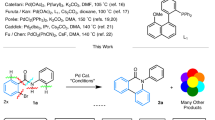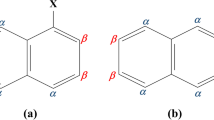Abstract
Quantum chemical calculations on the isomerization of 24-methylenecycloartanol are described. An energetically viable mechanism, with a rate-determining protonation step, is proposed. This rearrangement may find applicability in tests for determining if an olive oil has been refined.

The results of density functional calculations on the mechanism of a rearrangement of a sterol proposed to occur during olive oil heating are described. These results indicate that this rearrangement can indeed occur at a fast rate under refining conditions, but will not occur at an appreciable rate under conditions for producing extra virgin olive oil.




Similar content being viewed by others
References
Tripoli E, Giammanco M, Tabacchi D, Di Majo D, Giammanco S, La Guardia M (2005) The phenolic compounds of olive oil: structure, biological activity and beneficial effects on human health. Nutr Res Rev 18:98–112
US Department of Agriculture (2010) United States standards for grades of olive oil and olive-pomace oil. Federal Register 75:22363
Frankel EN, Mailer RJ, Shoemaker FC, Wang SC, Flynn JD (2010) Tests indicate that imported “extra virgin” olive oil often fails international and USDA standards. UC Davis Olive Center, Davis
Frankel EN, Mailer RJ, Wang SC, Shoemaker FC, Guinard J-X, Flynn JD, Sturzenberger ND (2011) Evaluation of extra-virgin olive oil sold in California. UC Davis Olive Center, Davis
Moore JC, Spink J, Lipp M (2012) Development and application of a database of food ingredient fraud and economically motivated adulteration from 1980 to 2010. J Food Sci 77:118–126
Morales MT, Przybylski R (2013) Olive oil oxidation. In: Aparicio R, Harwood J (ed) Handbook of olive oil. Springer, New York, pp 479–522
Aparicio R, Conte LS, Fiebig H-J (2013) Olive oil authentication. In: Aparicio R, Harwood J (ed) Handbook of olive oil. Springer, New York, pp 589–653
ISO (2009) Vegetable fats and oils: isomeric diacylglycerols: determination of relative amounts of 1,2- and 1,3-diacylglycerols (ISO 29822:2009). International Organization for Standardization, Geneva
ISO (2009) Vegetable fats and oils: determination of degradation products of chlorophyll a and a′ (pheophytins a, a′ and pyropheophytins) (ISO 29841:2009). International Organization for Standardization, Geneva
Antonopoulos K, Valet N, Spiratos D, Sirgakis G (2006) Olive oil and pomace olive oil processing. Grasas Acietes 57:56–67
Frisch MJ, Trucks GW, Schlegel HB, Scuseria GE, Robb MA, Cheeseman JR, Scalmani G, Barone V, Mennucci B, Petersson GA, Nakatsuji H, Caricato M, Li X, Hratchian HP, Izmaylov AF, Bloino J, Zheng G, Sonnenberg JL, Hada M, Ehara M, Toyota K, Fukuda R, Hasegawa J, Ishida M, Nakajima T, Honda Y, Kitao O, Nakai H, Vreven T, Montgomery JA, Peralta JE, Ogliaro F, Bearpark M, Heyd JJ, Brothers E, Kudin KN, Staroverov VN, Kobayashi R, Normand J, Raghavachari K, Rendell A, Burant JC, Iyengar SS, Tomasi J, Cossi M, Rega N, Millam JM, Klene M, Knox JE, Cross JB, Bakken V, Adamo C, Jaramillo J, Gomperts R, Stratmann RE, Yazyev O, Austin AJ, Cammi R, Pomelli C, Ochterski JW, Martin RL, Morokuma K, Zakrzewski VG, Voth GA, Salvador P, Dannenberg JJ, Dapprich S, Daniels AD, Farkas, Foresman JB, Ortiz JV, Cioslowski J, Fox DJ (2009) Gaussian 09, revision B.01. Gaussian, Inc., Wallingford
Adamo C, Barone V (1998) Exchange functionals with improved long-range behavior and adiabatic connection methods without adjustable parameters: the mPWand mPW1PW models. J Chem Phys 108:664–675
Tantillo DJ (2011) Biosynthesis via carbocations: theoretical studies on terpene formation. Nat Prod Rep 28:1035–1053
Hong YJ, Tantillo DJ (2010) Quantum chemical dissection of the classic terpinyl/pinyl/bornyl/camphyl cation conundrum—the role of pyrophosphate in manipulating pathways to monoterpenes. Org Biomol Chem 8:4589–4600
Fukui K (1981) The path of chemical reactions—the IRC approach. Acc Chem Res 14:363–368
Gonzalez C, Schlegel HB (1990) Reaction path following in mass-weighted internal coordinates. J Phys Chem 94:5523–5527
Marenich AV, Cramer CJ, Truhlar DG (2009) Universal solvation model based on solute electron density and on a continuum model of the solvent defined by the bulk dielectric constat and atomic surface tensions. J Phys Chem B 113:6378–6396
Lounnas V, Wedler H, Newman T, Schaftenaar G, Harrison J, Nepomuceno G, Pemberton R, Tantillo D, Vriend G (2014) Visually impaired researchers get their hands on quantum chemistry; application to a computational study on the isomerization of a sterol. J Comput-Aided Mol Des 28:1057–1067. doi:10.1007/s10822-014-9782-7
Lounnas V, Vriend G (2012) AsteriX: a web server to automatically extract ligand coordinates from figures in PDF articles. J Chem Inf Model 52:568–576
Scalfani VF, Vaid TP (2014) 3D printed molecules and extended solid models for teaching symmetry and point groups. J Chem Educ 91:1174–1180
Wedler HB, Cohen SR, Davis RL, Harrison JG, Siebert MR, Willenbring D, Hamann CS, Shaw JT, Tantillo DJ (2012) Applied computational chemistry for the blind and visually impaired. J Chem Educ 89:1400–1404
Supalo CA, Kennedy SH (2014) Using commercially available techniques to make organic chemistry representations tactile and more accessible to students with blindness or low vision. J Chem Educ 91:1745–1747. doi:10.1021/ed4005936
Legault CY (2009) CYLview 1.0b. C.Y. Legault, Universite de Sherbrooke, Sherbrooke. http://www.cylview.org
Toteva M, Richard JP (1996) Mechanism for nucleophilic substitution and elimination reactions at tertiary carbon in largely aqueous solutions: lifetime of a simple tertiary carbocation. J Am Chem Soc 118:11434–11445
Acknowledgments
We gratefully acknowledge support from the National Science Foundation (CHE-0957416 to DJT, a graduate research fellowship to HBW, and support through the XSEDE program). We also acknowledge T. Newman and G. Nepomuceno for their work on the development and implementation of AsteriX-BVI, and Dr. C. Hamann for valuable insight into IRC calculations.
Author information
Authors and Affiliations
Corresponding authors
Electronic supplementary material
Below is the link to the electronic supplementary material.
Supporting Information
Additional Supporting Information (details on computational approaches, along with coordinates and energies for computed structures and IRC data) may be found in the online version of this article. (PDF 3457 kb)
Rights and permissions
About this article
Cite this article
Wedler, H.B., Pemberton, R.P., Lounnas, V. et al. Quantum chemical study of the isomerization of 24-methylenecycloartanol, a potential marker of olive oil refining. J Mol Model 21, 111 (2015). https://doi.org/10.1007/s00894-015-2652-y
Received:
Accepted:
Published:
DOI: https://doi.org/10.1007/s00894-015-2652-y




